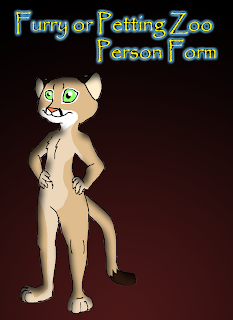A furry, or petting zoo person, is an animal with a fully anthropomorphic body. Their body is basically an animal's head, tail (if the species or character has one), skin, fur, feather, or scale coloring and pattern, and even feet stuck on a furry (feathered in the case of birds and scaly in the case of reptiles) human body. Their feet can be either digitgrade, unguligrade (standing on a hoof), or plantigrade and can be more animal-like or more human-like in basic shape. Their feet and hands can feature either feature pawpads and/or claws of varying degrees or bare palms and/or fingernails and toenails. They usually have humanlike breasts.

Furries nearly always think and act completely like human beings, but some can either live and/or be like civilized animals or like funny animals to some degree. They wear clothes just like a human would but the type of clothes varies with each setting and culture. In "modern" or science fiction settings and cultures, they will wear modern-day attire, while in fantasy or "native" settings and cultures, they might wear only a loincloth and jewelry, or even forego clothing entirely.
The term furry can either refer just to a humanoid mammal or to any kind of anthropomorphic animal. A humanoid bird is called an avian, and a humanoid reptile is called a scaly.
-------------------------------------------------------------------------------------------------------
Examples
-------------------------------------------------------------------------------------------------------
Examples On The Verge of Being Gijinka
-------------------------------------------------------------------------------------------------------
